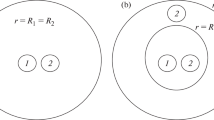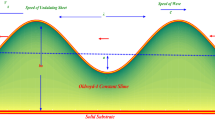Abstract
A mathematical model for cell sorting and migration in the slug stage of cellular slime moldsDictyostelium discoideum is proposed. Assuming that a slug is a “mixed fluid” of prespore and prestalk cells, a set of equations which describe the dynamics of cell distribution, internal pressure and velocity of hte slug are derived from the balance formula of individual cell movement. These equations are analyzed to obtain the spatial patterns of the two types of cells at dynamical equilibrium and the relationship between the migration velocity and the slug size. The body shape of the elongated slug at the migrating stage is also investigated, taking account of the law of surface tension. The stable shapes of slugs with different volumes are explicity obtaained and the existence of critical size of a slug is suggested.
Similar content being viewed by others
Literature
Bonner, J. T., P. G. Koontz Jr. and D. Paton. 1953. “Size in Relation to the Rate of Migration in the Slime MoldDictyostelium discoideum.”Mycologia 45, 235–240.
Farnsworth, P. A. and W. F. Loomis, 1975. “A Gradient in the Thickness of the Surface Sheath in Pseudoplasmodia ofDictyostelium discoideum.”Dev. Biol. 46, 349–357.
Goel, N. S. and N. Richter-Dyn. 1974.Stochastic Models in Biology. New York: Academic Press.
Hohl, H. R. and K. B. Raper. 1964. “Control of Sorocarp Size in the Cellular Smile MoldDictyostelium discoideum.”Dev Biol. 9, 137–153.
Inouye, K. and I. Takeuchi. 1979. “Analytical Studies on Migrating Movement of the Pseudoplasmodium ofDictyostelium discoideum.”Protoplasma 99, 289–304.
—. 1980. “Motive Force of the Migrating Psuedoplasmodium of the Cellular Slime MouldDictyostelium discoideum.”J. Cell Sci. 41, 53–64.
Kobuchi, Y. 1985. “A Density Dependent Model for Prestalk/Prespore Pattern Formation inDictyostelium discoideum I. Basic Mathematic Framework.” In:Mathematical Topics in Population Biology, Morphogenesis and Neurosciences E. Teramoto and M. Yamaguti (eds),Lecture Notes in Biomathematics, Vol. 71, pp. 234–243. Berlin: Springer-Verlag.
Kopachik, W. 1982. “Size Regulation inDictyostelium”J. Embryol. exp. Morph. 68, 23–35.
Landau, L. D. and E. M. Lifshitz. 1959.Fluid Mechanics (translated by J. B. Sykes and W. H. Reid). Oxford: Pergamon Press.
MacWilliams, H. K. and J. T. Bonner, 1979. “The Prestalk-Prespore Pattern in Cellular Slime Molds.”Differentiation 14 1–22.
Matsukuma, S. and A. J. Durston. 1979. “Chemotactic Cell Sorting inDictyostelium discoideum.”J. embruol. exp. Morph. 50, 243–251.
Odell, G. M. and J. T. Bonner. 1986. “How theDictyostelium discoideum Grex Crawls.”Phil. Trans. R. Soc. 312, 487–525.
Pate, E. F. and H. G. Othmer. 1986. “Differentiation, Cell Sorting and Proportion Regulation in the Slug Stage ofDictyostelium discoideum.”J. theor. Biol. 118, 301–319.
Rubinow, S. I., L. A. Segel and W. Ebel. 1981. “A Mathematical Framework for the Study of Morphogenetic Development in the Slime Mold.”J. theor. Biol. 91, 99–113.
Shaffer, B. M. 1965. “Cell Movement within Aggregates of the Slime MouldDictyostelium discoideum Revealed by Surface Markers.”J. Embryol. exp. Morph. 13, 97–117.
Sternfeld, J. and C. N. David. 1981. “Cell Sorting during Pattern Formation inDictyostelium.”Differentiation 20, 10–21.
Takeuchi, I., M. Tasaka, M. Oyama, A. Yamamoto and A. Amagai. 1982. “Pattern Formation in the Development ofDictyostelium discoideum.” InEmbryonic Development, M. M. Burger and R. Weber (eds.), pp. 283–294. New York: Liss.
Teramoto, E. 1985. “An equilibrium Theory of Cell Distribution inDictyostelium discoideum.” InMathematical Topics in Population Biology, Morphogenesis and Neurosciences, E. Teramoto and M. Yamaguti (eds),Lecture Notes in Biomathematics, Vol. 71, pp. 217–223. Berlin: Springer-Verlag.
Author information
Authors and Affiliations
Rights and permissions
About this article
Cite this article
Umeda, T. A mathematical model for cell sorting, migration and shape in the slug stage ofDictyostelium discoideum . Bltn Mathcal Biology 51, 485–500 (1989). https://doi.org/10.1007/BF02460086
Received:
Revised:
Issue Date:
DOI: https://doi.org/10.1007/BF02460086




